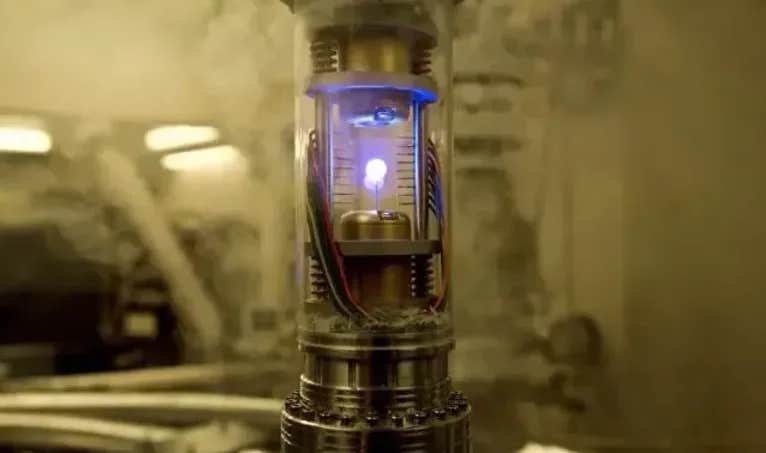This rare substance costs an amazing $62,000,000,000,000 per gram
Typically, the term “expensive” evokes images of luxury yachts, sprawling mansions, or even the intangible worth of love.

With its jaw-dropping valuation at approximately $62.5 trillion per gram, this substance demands the world’s attention. (CREDIT: Creative Commons)
When you think of Earth's riches, diamonds, gold, and rare earth minerals likely come to mind. However, beyond these tangible assets lies a substance that's not only elusive but also carries an astronomical price tag: antimatter.
Valued at a staggering $62.5 trillion per gram, antimatter captivates attention not for its appearance but for its remarkable properties and immense potential.
Typically, the term "expensive" evokes images of luxury yachts, sprawling mansions, or even the intangible worth of love. Yet few would associate it with an almost mythical substance produced deep within the underground chambers of particle accelerators.
Unlike precious gems and metals, antimatter isn’t mined or extracted from the earth. It is the result of relentless human ingenuity and scientific innovation, showcasing the heights of modern physics.
To begin with, what is this elusive and costly antimatter? The very stuff our universe is built on - matter - consists of particles we've long understood, namely protons, electrons, and neutrons. However, a groundbreaking revelation came in 1930 when physicist Paul Dirac introduced the world to the notion of 'antiparticles'. These were not just theoretical musings.
Dirac's work led to the discovery of the positron or antielectron, a particle with identical mass to the electron but with an opposing charge. Following the same logic, antiprotons and antineutrons were identified as the antithesis to their regular matter counterparts.
As poetic as the dance of yin and yang, matter and antimatter engage in a spectacular tango. But this is a dance of mutual destruction. Their union leads to annihilation, giving rise to energy in a display that underscores Einstein's iconic E = mc².
The energy emerging from a matter-antimatter annihilation dwarfs even the most explosive reactions we know, such as nuclear explosions. Its potential energy release, unimaginably more powerful than our most potent explosives, makes TNT seem trivial and places nuclear blasts in the shadows.
Related Stories:
Yet, the potential of antimatter isn't mere fantasy. Its unparalleled energy has the scientific community brimming with excitement and curiosity. However, harnessing its power is no trivial feat.
The saga begins with the unassuming hydrogen atom, comprising one proton and one electron. Its antithesis, antihydrogen, plays a pivotal role in the tale of antimatter. Like matter’s Romeo and Juliet, the positron feels an irresistible pull towards the antiproton, mirroring the attraction between electrons and protons.
The creation of antihydrogen is a story of collisions and cosmic orchestration. History was made at the CERN super collider in 1995, where a significant breakthrough saw antiprotons smashing into xenon atoms, leading to the generation of positrons. These positrons, in turn, combined with antiprotons, culminating in the birth of antihydrogen.
Given antimatter's volatile nature, ensuring its stability became paramount. Scientists achieved a milestone by cooling antihydrogen to near absolute zero, thereby extending its life and minimizing its explosive tendencies.
Unraveling the staggering cost of antimatter brings us to the doorstep of technological marvels. The meticulous creation of antiprotons necessitates precision and innovation at the atomic level. This undertaking is brought to life in the sprawling circuits of particle accelerators like the CERN super collider, a 10-mile long behemoth.
Built over a decade with an investment of $4.75 billion, it houses 9300 state-of-the-art super-cooled magnets. Its operations, running at an astounding 99.99% of light's speed, consume a staggering 120 MW of electric power, tantamount to energizing an entire metropolis.
With an annual running cost of $1 billion, where merely the electricity bill tallies up to $23.5 million, it’s no surprise that producing even a gram of antihydrogen is projected to take an almost mythical 100 billion years.
Antimatter, in its elusive glory, represents both a scientific marvel and an economic wonder. The hefty price tag it commands results from the perfect storm of cutting-edge technology, immense energy consumption, and the sheer tenacity of researchers.
As we inch closer to unlocking the secrets of antimatter, one undeniable fact remains: true knowledge and potential come at a cost, and in the realm of antimatter, that cost is a staggering $62.5 trillion per gram.
Note: Materials provided above by The Brighter Side of News. Content may be edited for style and length.
Like these kind of feel good stories? Get The Brighter Side of News' newsletter.
Joseph Shavit
Head Science News Writer | Communicating Innovation & Discovery
Based in Los Angeles, Joseph Shavit is an accomplished science journalist, head science news writer and co-founder at The Brighter Side of News, where he translates cutting-edge discoveries into compelling stories for a broad audience. With a strong background spanning science, business, product management, media leadership, and entrepreneurship, Joseph brings a unique perspective to science communication. His expertise allows him to uncover the intersection of technological advancements and market potential, shedding light on how groundbreaking research evolves into transformative products and industries.



